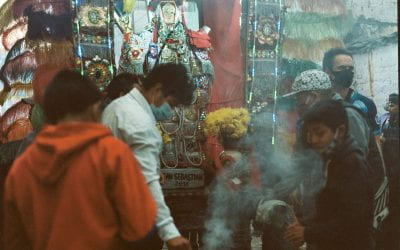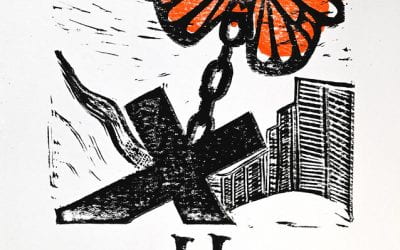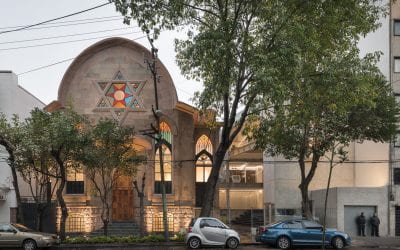A Quest for Contemporary Maya and Aymara Spirituality and Identity
Finding Answers in the Land
I remember Coba, Quintana Roo, as a remote and sleepy Maya village in the 1990s, which had to be reached by a good hour-long drive on a narrow road inland from Tulum. We stayed at the Villa Arqueologica, an upscale hotel, at that time the only tourist hotel in Coba. I recall the muddy dirt access road to the hotel and being woken up by roosters in the neighbors’ gardens. The Villa Arqueologica was situated on the shores of Lake Coba and a short walk along the lake took us to the archaeological site with its numerous pyramids which functioned as Classic Maya religious foci.
When I returned in 2012, most roads had been widened and paved; the archaeological site now features a large parking lot with an extensive arts and crafts market; colorful tourist art from all over Mexico is offered throughout the village; and after exploring ancient Coba, visitors can eat lunch of local or international foods in a spacious restaurant and swing on a zip line over Lake Coba.
I felt confused and inspired to investigate what has happened to the “Maya”? Naively, I had assumed that the Cobaneros of today had to know best the culture of their ancestors who built the ancient city in the Late Classic, approximately 600 – 800 A.D. However, Cobaneros of today mostly worship in Protestant houses of various denominations and in one Catholic chapel. I continued to ask myself what has happened to “Maya” identity, what does it mean to be “Maya” today in Coba, and whether the religious ceremonies and spirituality of the past have been consumed by the advances of Christianity and a global capitalist tourism industry?
I encountered a similar case scenario in Copacabana, Bolivia, situated on the south shore of Lake Titicaca. In the 15th and early 16th centuries, Copacabana functioned as an important Inka administrative center which oversaw the pilgrimage from Cusco to the sacred sites on the Islands of the Sun and Moon in Lake Titicaca.
During the course of the Spanish Invasion in the 16th century, the Inka were defeated and an influential Catholic Convent with the Basilica of the Virgin of Copacabana were established in Copacabana. Today the local people speak Aymara, are mostly unrelated to the Inka, and continue a lifestyle based primarily on agriculture and herding. Tourism to the island sanctuaries and on pilgrimage days to the Virgin has been slowly introduced, primarily from companies in La Paz, the Bolivian capital.
I gradually came to the realization that both Coba and Copacabana demonstrate a worldview and spirituality grounded in local lands and community that can offer intriguing, sustainable and possibly regenerative alternatives to the Western value system centered on individual competition.
These encounters with religion and spirituality in Coba and Copacabana from the past to the present led me to ask many questions. Are there commonalities in these communities which after my cursory descriptions appear so different? How do religion and spirituality map a worldview grounded in indigenous concepts of land and knowledge systems which are useful in the present and can clear a path to a regenerative planet?
Maya Coba, Quintana Roo
The Maya in the Late Classic, about 600-800 A.D., and Post-Classic, about 1250-1400 A.D. constructed the buildings we can visit and climb at the archaeological site today. They formed downtown of the polity of Coba with neighborhoods extending outward in radial zones, as has been documented in works by William Folan, such as William Folan, Ellen R. Kintz and Laraine A. Fletcher, Coba: A Classic Maya Metropolis. Coba Archaeological Mapping Project, among other works published by Maya and Mexican scholars.

Coba, Ixmoja Pyramid in the Nohoch Mul Group, a Classic Maya religious focal point. Photo by the author.
Governance rested in the hands of a sovereign with the Yucatec Maya title halach uinic and a council of elites. The neighborhoods had lower-level, local leaders who coordinated tribute of agricultural products between their districts and the sovereign as documented in Ellen Kintz’ 1978 Ph.D. anthropology dissertation of, The Social Organization of a Classic Maya City, Coba, Quintana Roo, Mexico (State University of New York, Stony Brook.)
After about 1500 A.D., archaeological records in Coba fall silent. During the Colonial Period, the area was sparsely populated; in the second half of the 19th century, Coba lay at the periphery of the Caste War. Oral traditions recall that the modern town began to be settled in the 1950s, first by chicleros—men who collect gum resin from chicle trees in the rain forest— and later by families from nearby villages. They quickly established their milpa, land cultivated in the traditional Maya system.
Following the Mexican agrarian reform in the 1930s, Coba received the status of ejido in the early 1970s. The concept of an ejido was to expropriate land from colonial and owners and give it to communities as land grants to be parceled out to individual ejidatarios. The original ejidatarios had to work their land and keep it within their families; they formed a council that still exists today to manage the ejido, as described by Stephanie Litka, “The Maya of Coba: Managing Tourism in a Local Ejido,” Annals of Tourism Research, 2013. The 1992 Agrarian Law changed the ejidal system giving ejidatarios the right to lease, buy or sell land; they may also petition for the title of private ownership. Here we clearly see how national neoliberal policies undermine community land management, issues investigated by Sarah Taylor for EkBalam in On Being Maya and Getting By: Heritage Politics and Community Development in Yucatán (University Press of Colorado, Boulder, 2018).
What does the ejido have to do with the Classic Maya site and religion and spirituality in Coba? I have learned that land and people’s relationships with the milpa and forest form the connecting links. In Classic Coba, commoners living in the neighborhoods were full time farmers, beekeepers and hunters. They intimately experienced and knew the ecology of their natural setting and tried to influence natural forces in their favor through household rituals as shown by Ellen Kintz, Life under the Tropical Canopy: Tradition and Change among the Yucatec Maya (Holt, Rinehart, and Winston, Fort Worth, TX, 1990).
It is true that contemporary Cobaneros know little about the ecology around them: few family members actively practice milpa farming; most of the town’s income is derived from tourism-related businesses. Nevertheless, the majority of ejidatarios keep a portion of their land as backup asset in case tourism fails. The current Covid pandemic is a salient example: in the spring of 2020, Coba was closed and received almost no visitors for months. Milpa farming offered a subsistence Plan B and some self-sufficiency.
Some elders still know traditional ecology and sense relationships with the milpa and forest. They are hard to find in Coba. Therefore I am referencing another case study of ejidos in the Si’aan Kaan Reserve, just south of Tulum in Quintana Roo by Jose Martinez-Reyes, Moral Ecology of a Forest (University of Arizona Press, Tucson, 2016). Martinez-Reyes asked elders in the ejidos Chunyaxche and Tres Reyes “Bix u ya’alal ‘naturaleza’ ich maya ?” (How do you say nature in Maya ?). He learned that the Yucatec Maya do not have one word equivalent to English “nature.” The elders answered his question with k’aax (forest), lu’um (soil, land), and yokol k’ab (universe). They explained that the Maya concept of nature lies in this continuum of yokol k’ab, k’aax, kaj (town), and all its lifeforms. Yokol k’ab is the “universe” which hosts the material world including the forest (k’aax) and the towns and villages of the people (kaj) as well as the cosmological world of ancestor spirits and deities. This relational network of kaj, k’aax, and yokol k’ab circumscribes Maya ontological ecology, including spirituality.
The elders mentioned various protector spirits and spirit-winds whom traditional Maya try to influence to their favor through ceremonies: the yuntsilo’ob are the owners and caretakers of the forest and animals; ah kunal are guardians who protect each person’s space, house and garden; balam- kaajo’ob are protectors of the community; nojoch balamo’ob are protectors of the milpa; kisin (devil) and arux are tricksters who can do good or bad, depending on whether they have received adequate offerings.
Traditional Maya life, including religion and spirituality, in the Yucatan peninsula is grounded in the interrelationships between people, the village (kaj) and the forest (k’aax) from which the milpa is cleared. “The forest exists, but by dwelling in it and engaging it, it gives life and the Maya ecology comes into being” (Martinez-Reyes 2016:107). Religion and ritual activate sacred aspects of the land, making humanity part of the earth and nature in a reciprocal bond. I recently learned from a consultant and friend in Coba that elders in his hometown Dzan, Yucatan, answer the question “how do you say nature in Maya ?” with ‘Sijnáalil Yóok’olkab’ meaning “the birth of the universe.” This is a powerfully succinct image of this interconnectedness of life forms and the key to Maya religion and spirituality.
Aymara Copacabana, Bolivia
I began visiting Copacabana in the 1990s to learn more about the well known Inka sanctuaries on the Islands of the Sun and Moon in Lake Titicaca. These sanctuaries were major state wak’a—a sacred object or site which is a living social being and can distribute its lifeforces to other wak’a. Traveling from Peru to Copacabana, we can retrace part of the Inka-sponsored pilgrimage to the islands, in which Copacabana was the primary administrative center, reconstructed archaeologically by Brian S. Bauer and Charles Stanish in their 2001 book Ritual and Pilgrimage in the Ancient Andes. The Islands of the Sun and Moon (University of Texas Press, Austin, 2001), among their many other extensive writings on the subject.
As I expanded my readings, I became increasingly interested in the contemporary town and religious practices surrounding the Virgin of Copacabana, so beloved by the people in the region. I attended the August 6 pilgrimages to this Virgin in 2015 and 2017 and discovered that Aymara spirituality is lived and performed not only in the Basilica but also in selected places in the surrounding landscape. Local people take over certain cave sites linked with oral narratives and convert them into new shrines or wak’a.
The most memorable new wak’a are the so-called Virgen of Lourdes and the Boca del Zapo site. The Virgen of Lourdes occupies a cave-like niche in a cliff about half-an-hour drive up the peninsula. During pilgrimage week, hundreds of people line up on the zigzag trail leading to the cave in hopes of petitioning the Virgin for health, a new car, money, blessings for family and wellbeing in general. Many bring small gifts or miniatures of the objects they desire. Aymara shamans set up their tables in between along the hillside. They can be contracted for additional blessing ceremonies.
Most mysterious to me were the many people who labor to loosen rocks from the hillside, using other rocks as stone tools. After consulting with various families I learned that people make a commitment to the Virgin of Lourdes to attend the pilgrimage three years in a row. Each year, they collect some stones from the hillside and store them in a bag. During the third visit, they deposit their bag filled with rocks on a heap of other bags near the Virgin’s cave. Shamans perform ceremonial blessings of the bags; this will guarantee fulfillment of the wishes brought to the Virgin by each family.
On the drive back to Copacabana, we stopped at another cave site with a Virgin, called the Virgen de Urkupina. Her caves are smaller. People leave more modest offerings of colored paper ribbons, confetti, and candles and do not collect rocks.
The third wak’a, Boca del Zapo, is situated on the shores of Lake Titicaca below the Catholic and Aymara sanctuaries of Mount Calvario and Santa Barbara. Boca del Zapo is a boulder of unusual shape which vaguely resembles the head of a frog with its mouth open. People line up to shower him with sprayed beer, colored ribbons and confetti in hopes he would fulfill their wishes. During pilgrimage days, an attendant with a rake has to stand by to clean out old offerings. Most interestingly, a small concrete dome encases another statue of a Virgin near the path leading down to El Zapo. At the water’s edge, on a cliff wall above the Boca del Zapo shines a large painting depicting the Inka ancestors Manqo Qhapaq and Mama Oqllu rising out of Lake Titicaca as told in Inka origin narratives. Thus the site of Boca del Zapo merges Aymara, Christian and Inka religion and spirituality in most compelling ways.
- Boca del Zapo, boulder and people making offerings, Copacabana. Photo by the author.
- Concrete dome with a virgin statue on the path down to El Zapo, Copacabana. Photo by the author.
- Painting of the Inka ancestors on a cliff wall above Boca del Zapo, Copacabana. Photo by the author.
Spirituality Anchored in the Land
What links these two superficially very different communities are a spirituality and worldview deeply anchored in their surrounding lands and natural setting. Traditional Maya farmers have hunted and worked the milpa as subsistence farming and know the forest from the inside as daily lived experiences. Their worldview has been shaped by the ongoing relations between people in their villages (kaj), the forest (k’aax) and its soils (lu’um). The universe (yokol k’ab) arises out of these relations and can be petitioned for blessings through religious practices.
The highlands surrounding Copacabana are structured by high mountains which oversee human villages and have been animated and personified in multiple ways throughout Andean history. They are apu [lords], ancestors, protectors, and wak’a. Caves form openings into the mountain’s body and access paths to its energy. Selected boulders and rocks, like the Boca del Zapo, can become partible parts of the mountain wak’a and carry its agency. At such potent places local people in Copacabana release their spirituality and perform a contemporary religion which merges the Aymara and Inka past with the Christian presence.
Traditional indigenous knowledge systems in Coba as well as in Copacabana explain human existence as intimate relationships between people and a living natural setting. It is a religion derived from the physical environment and a community-wide spirituality. We are offered a choice to navigate in a similar direction as an alternative to our Western insulated, virtual, and market-driven existence. For us, this could mean choosing to distance from our self-centered lives and competition and instead to fully embrace relational networks among all living beings around us. The current Covid pandemic undermines values of a physical community and its effects upon indigenous systems will have to be evaluated.
Winter 2021, Volume XX, Number 2
Jessica Joyce Christie is Full Professor at East Carolina University. Her research has been focused on the Maya, Inka, the Southwest of Native North America, and more recently on Hawai’i. She has published two single-authored books and four edited volumes.
Related Articles
Translating the Maya Popol Wuj
It’s the 20th of December and we are in Chichicastenango for its Fiesta Patronal. Just after 3:33 A.M., we are woken up by powerful explosions right above the Hotel Pop Wuj where
Witnessing the Seeds of Liberation
Having first learned about liberation theology in college, I arrived at Harvard Divinity School in the mid 1990s with a desire to deepen my understanding of this historic movement…
Exploring Mexican Judaism
I was shivering on that sunny warm Mexico City afternoon in March 2019. The climate-controlled archives of the newly inaugurated Colección Centro de Documentación e Investigación de la Comunidad Ashkenazi de México (CDIJUM) were otherwise a delight…










